Schedule a Dermal Filler Consultation with Dr. Laura Geige Now
Bruising Causes
Types of Bruising
Bruising after lip filler injections is a common side effect, typically appearing within a few hours to a day after treatment and resolving gradually over several days to a week.
Bruising occurs when tiny blood vessels under the skin rupture, releasing blood into the surrounding tissues.
Here are some causes of bruising:
- Trauma to the skin
- Inflammation
- Blood clotting disorders
- Certain medications, such as aspirin or blood thinners

During lip filler injections, a needle is inserted into the lips to deliver the dermal filler. This can cause minor trauma to the skin and underlying tissues, leading to bruising.
The amount of bruising varies depending on several factors:
- Individual susceptibility
- Injection technique
- Type of filler used
- Pre-existing conditions or medications
Here are some types of bruising you might encounter after lip filler injections:
- Petechiae: Tiny, pinpoint red or purple spots caused by bleeding into the skin
- Purpura: Larger, more widespread purplish areas of discoloration
- Ecchymosis: The most common type of bruising, characterized by a raised, bluish-purple mark.
It’s important to note that while bruising is a common side effect, it should not be excessive or severe. If you experience any unusual or concerning symptoms, such as prolonged swelling, redness, pain, or fever, consult your doctor immediately.
Contributing Factors
Bruising after lip filler is a common side effect, typically occurring due to the minor trauma inflicted during the injection process.
The needle punctures the skin, causing blood vessels to break, resulting in the accumulation of blood under the skin, manifesting as a bruise.
Several factors can influence the severity and duration of bruising.
**Genetics** plays a role; some individuals are more predisposed to bruising due to thinner or more delicate capillaries.
**Blood thinners**, both prescription and over-the-counter medications like aspirin, ibuprofen, or even supplements like fish oil, can increase the risk and duration of bruising.
Certain **medical conditions** such as vitamin C deficiency, platelet disorders, or collagen vascular diseases can also contribute to excessive bruising.
Injection technique matters. A skilled injector using proper techniques can minimize trauma and reduce bruising.
The **type and amount of filler** injected can also impact bruising. Thicker fillers may cause more noticeable bruising compared to hyaluronic acid gels.
**Sun exposure** before or after the procedure can worsen bruising by dilating blood vessels.
Smoking is known to impair healing and increase bruising risk.
Lastly, **age** can be a factor, as aging skin tends to bruise more easily due to thinning and loss of elasticity.
Managing Bruising
Home Care Tips
Bruising after lip filler injections is a common side effect and typically resolves on its own within a few days to a week. While it can be alarming, understanding how to manage the bruising effectively can help minimize its appearance and promote faster healing.
Here are some home care tips to manage bruising following lip filler treatment:
**1. Apply Cold Compresses:**
Immediately after your appointment, apply a cold compress to the treated area for 10-15 minutes at a time, several times a day. This helps constrict blood vessels, reducing swelling and minimizing bruising.
**2. Elevate Your Head:**
Sleeping with your head slightly elevated can help drain excess fluid from the area, further reducing swelling and bruising.
**3. Avoid Touching or Rubbing:**
Resist the urge to touch, rub, or pick at the bruised area as this can irritate it and potentially worsen the discoloration.
**4. Over-the-Counter Pain Relievers:**
If you experience discomfort or pain, over-the-counter pain relievers such as ibuprofen or acetaminophen can be helpful in managing the symptoms.
**5. Arnica Gel or Cream:**
Arnica is a natural remedy that has traditionally been used to reduce bruising and inflammation. Applying arnica gel or cream to the affected area may help promote healing and minimize discoloration.
**6. Stay Hydrated:**
Drinking plenty of water helps flush toxins from the body and can support the healing process.
**7. Avoid Alcohol and Smoking:**
Alcohol and smoking can impair blood circulation and delay healing, potentially making bruising worse.
**8. Protect the Area from Sun Exposure:**
Once the initial bruising has subsided, protect the treated area from direct sun exposure as UV rays can darken discoloration.
Remember that individual healing times vary. If you have concerns about the extent or duration of your bruising, consult with your doctor or the injector who performed the treatment.
Arrange Your Dermal Filler Session with Dr. Laura Geige
When to See a Doctor
Bruising after lip filler is a common side effect and typically resolves within a few days to a week. However, it’s important to understand how to manage bruising and when to seek medical attention.
Managing Bruising
Here are some tips for managing bruising after lip filler:
-
Apply a cold compress to the area for 10-20 minutes at a time, several times a day. This can help reduce swelling and inflammation.
-
Elevate your head while sleeping to minimize swelling.
-
Avoid touching or rubbing the bruised area as this can worsen bruising.
-
Wear loose-fitting clothing that doesn’t put pressure on the treated area.
-
Arnica cream may help reduce bruising. Consult with your injector or a pharmacist for recommendations.
-
Excessive bruising that doesn’t improve within a week.
-
Significant swelling or pain that worsens or doesn’t subside.
-
Redness, warmth, or pus drainage from the injection site, which could indicate infection.
-
Vision changes, numbness, or difficulty speaking, as these could be signs of a serious complication.
-
Day 1-2: Swelling, redness, and tenderness are most pronounced. Applying ice packs for 15-20 minutes at a time can help minimize swelling.
-
Day 3-5: Swelling begins to subside, but some bruising may still be present.
-
Week 1: Most swelling and bruising have resolved. Lip shape continues to settle as the filler integrates with your tissue.
-
Week 2-4: The final lip shape is evident. Any remaining minor swelling or tenderness should dissipate.
-
Amount of filler injected:** Larger volumes require more healing time.
-
Individual healing rate: Some people heal faster than others.
-
Age: Younger individuals often heal quicker.
-
Overall health: Pre-existing conditions or medications can influence recovery.
-
Sun exposure:** Protect your lips from the sun during the healing process as UV rays can cause irritation and prolong recovery.
When to See a Doctor
While most bruising resolves on its own, it’s essential to seek medical attention if you experience any of the following:
Book a Consultation for Dermal Fillers at It’s Me and You Clinic with Dr. Laura Geige
Prompt medical attention can help prevent complications and ensure proper healing.
Recovery Timeline
General Healing Process
Bruising after lip filler is a common side effect, typically appearing within a few hours to a couple of days after treatment.
The _recovery timeline_ for bruising varies depending on factors such as the individual’s skin type, injection depth, and product used.
Most people experience peak bruising around **day 2 or 3**, with gradual improvement over the next few days.
Here’s a general breakdown of the healing process:
_Day 1-2:_ Bruising begins to appear, often as a light reddish hue. Swelling and tenderness may also be present.
_Day 3-5:_ Bruising intensifies, reaching its peak intensity. Swelling starts to subside.
_Day 6-10:_ Bruising begins to fade and turn yellowish-green. Swelling continues to decrease.
_Week 2:_ Most bruising has dissipated, leaving behind minimal discoloration.
_Weeks 3-4:_ Any remaining discoloration should completely fade away.
Tips for Minimizing Bruising:
– Avoid alcohol and blood thinners before and after treatment.
– Apply a cold compress to the treated area for 10-15 minutes at a time, several times daily.
– Elevate your head while sleeping.
– Use gentle skincare products and avoid harsh scrubs or exfoliation.
If you experience excessive bruising, unusual swelling, or other concerning symptoms, consult with your injector immediately.
Factors Affecting Recovery Time
Recovery time after lip filler injections varies depending on several factors and generally takes a few days to a week.
Here’s a breakdown of the typical recovery timeline:
Factors that can affect recovery time include:
It’s important to follow your injector’s post-treatment instructions carefully for optimal healing and results. Avoid activities that involve strenuous exercise, alcohol consumption, or heat exposure immediately after the procedure.
MS Style and Grace Press on Honey Pinnacle Wellbeing Media Andrea McGinty Art
- Why Are My Lips Dry After Lip Filler - November 1, 2025
- What Is Temple Filler - October 29, 2025
- Weed Seltzers With The Best Packaging - October 26, 2025
